E.T. the Extra-Terrestrial appears in an aspect ratio of approximately 1.85:1 on this single-sided, double-layered DVD; the image has been enhanced for 16X9 televisions. For this section, I reviewed only the 2002 version of E.T.; I’ll discuss the original 1982 cut when I get to the supplements. Despite my misgivings about the content of the 2002 edition, the picture looked quite good for the most part.
Sharpness seemed solid. The image always came across as nicely crisp and distinct, and I noticed no issues related to softness. Instead, the movie remained accurate and well defined. However, I noticed some light edge enhancement, and both jagged edges and moiré effects cropped up more often than I’d like. The latter mostly appeared during early shots with E.T. in Elliott’s bedroom. From the blinds to the closet slats to Elliott’s long johns, I detected a little more shimmer than normal. Additional concerns showed up in other scenes – roofs on houses also demonstrated some moiré effects – but the Elliott’s bedroom segments had the most prominent examples.
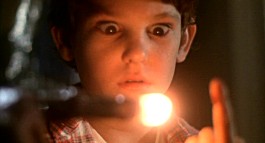 Despite the advancing age of E.T., the movie displayed virtually no defects. I witnessed no examples of grit, speckles, grain, or other issues. Instead, the film remained clean and fresh from start to finish.
Despite the advancing age of E.T., the movie displayed virtually no defects. I witnessed no examples of grit, speckles, grain, or other issues. Instead, the film remained clean and fresh from start to finish.
E.T. featured a warm and natural palette that the DVD replicate effectively. The hues stayed smooth and clean at all times, and they also came across as nicely vivid and bright. The colors showed strong tones that kept me impressed. Black levels also appeared deep and rich, while shadow detail was appropriately thick but didn’t seem too dense or dark. Without the light edge enhancement and shimmering concerns, E.T. would have earned an “A”, but it still merited a solid “B+”.
As for the audio of E.T., I encountered two main soundtrack options. The 2002 cut included both Dolby Digital EX 5.1 and DTS ES 6.1 mixes. I thought the two largely sounded pretty similar, though each differed somewhat and had their own plusses and minuses.
The DTS track featured a moderately more active soundfield, a fact that I regarded as a minor negative. Frankly, the DTS mix seemed a little too active, as though the sound designers tried to hard to reinvent the wheel. This didn’t come across as overwhelming, but at times the mix displayed a bit too much material from the sides and rears, which made it appear slightly unnatural for this kind of film.
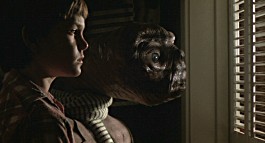 On the other hand, the Dolby track kept things more firmly focused on the front, which seemed to make more sense for E.T.. Despite the forward emphasis, the Dolby version demonstrated a nice sense of atmosphere and the different elements blended together well. During the louder sequences, the track came to life nicely and used all five channels well. E.T.’s ship zoomed cleanly from front to back, and the kids’ bicycles zipped around neatly. The DTS track mainly duplicated this one’s soundfield, but its moderately higher level of activity made it a little distracting at times.
On the other hand, the Dolby track kept things more firmly focused on the front, which seemed to make more sense for E.T.. Despite the forward emphasis, the Dolby version demonstrated a nice sense of atmosphere and the different elements blended together well. During the louder sequences, the track came to life nicely and used all five channels well. E.T.’s ship zoomed cleanly from front to back, and the kids’ bicycles zipped around neatly. The DTS track mainly duplicated this one’s soundfield, but its moderately higher level of activity made it a little distracting at times.
More differences appeared when I examined the quality of the two soundtracks, and the DTS mix won that battle by a hair. Both featured natural and warm speech that showed no problems related to intelligibility or edginess. Effects came across as clean and distinct. They played a relatively minor role in much of the film, but they also sounded accurate, and when required to take a more prominent part – mainly during the flick’s last act – they were nicely dynamic and vibrant. Music worked best of all, as John Williams’ score appeared rich and vivid, with clear highs and rich lows.
Though both tracks sounded good, the DTS one presented slightly stronger audio. That piece presented clearer highs and more powerful bass. As with the soundfields, the differences weren’t enormous, but I did prefer the quality of the DTS mix. However, since I liked the more natural scope of the Dolby soundfield, my comparisons ended up in a wash, and I gave both tracks “A-“ grades. No matter which one you choose, you should feel happy with the results, as both mixes seemed very strong given the age of the original material.
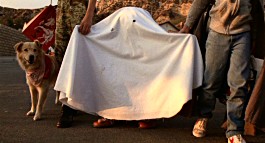 Consumers will find a number of different DVD versions of E.T. on the market. Most folks will opt for the standard 2-DVD package, while I went for this 3-DVD “Ultimate Gift Set”. Since I don’t have the 2-disc affair, I can’t make direct comparisons, but based on what I know, I’ll try to point out materials that appear exclusively in the shorter package. Features found only in this set will be differentiated with an asterisk. Take some of these with a potential grain of salt, though. I’ve found lots of inconsistent information about the two different sets so I’m not always sure that the comparisons are accurate.
Consumers will find a number of different DVD versions of E.T. on the market. Most folks will opt for the standard 2-DVD package, while I went for this 3-DVD “Ultimate Gift Set”. Since I don’t have the 2-disc affair, I can’t make direct comparisons, but based on what I know, I’ll try to point out materials that appear exclusively in the shorter package. Features found only in this set will be differentiated with an asterisk. Take some of these with a potential grain of salt, though. I’ve found lots of inconsistent information about the two different sets so I’m not always sure that the comparisons are accurate.
On DVD One, we encounter a few small extras. When you enter the “Bonus Materials” area, you first find An Introduction By Steven Spielberg. In this 115-second clip, he mostly tells us why he decided to “update” E.T. for the 2002 reissue.
John Williams Live at the Shrine Auditorium 2002 Premiere offers a very cool alternate audio track. During that premiere of the E.T. special edition, Williams led a live orchestra in a performance of the movie’s score that accompanied the film. Presented with Dolby Digital 5.1 sound, this piece integrates the live music with the flick’s dialogue and effects, so it provides a very interesting way to watch the movie. It also features some crowd noise from the presentation, so you’ll hear laughing and cheers at appropriate times.
Aimed at the kiddies, Space Exploration issues a basic lesson about our galaxy. You can click on any of the nine planets as well as the sun and the Earth’s moon and then get some quick facts about them. Bizarrely, the program’s producers decided to use someone to play E.T. (badly) to narrate these pieces. This makes the moderately informative snippets something of a chore to watch; they proceed slowly to accommodate E.T.’s vocal patterns, and that voice gets pretty annoying before too long. Still, “Space Exploration” gives a decent little rudimentary astronomy seminar for the young ones.
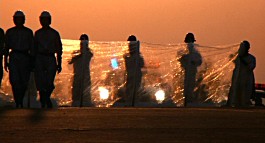 That completes the first disc, so now we move to DVD Two. Frankly, I don’t know if I should consider the 1982 theatrical cut of E.T. as an “extra”, but I’ve done the same for sets like Legend, so it made sense here as well.
That completes the first disc, so now we move to DVD Two. Frankly, I don’t know if I should consider the 1982 theatrical cut of E.T. as an “extra”, but I’ve done the same for sets like Legend, so it made sense here as well.
If you read my review of the movie, you’ll know my feelings about the theatrical version of E.T., and although the 2002 cut wasn’t the abomination I expected, I still definitely prefer the original release. Quality-wise, this transfer of the 1982 version holds up well, though it doesn’t look quite as good as the 2002 one. The image seemed a little softer throughout the film, and it also appeared a bit more muted. Blacks were a bit flat, and shadows came across as slightly heavy. The picture remained quite good, but it just didn’t look as solid as the 2002 release.
One bizarre and annoying aspect of this set relates to the audio properties of the 1982 cut. From what I understand, the 2-DVD release lets you view this version with either Dolby Digital 5.1 or DTS 6.1 mixes, whereas the “Ultimate Gift Set” only provides the Dolby Digital option. It’s bad enough that neither of them features the movie’s original Dolby Surround mix, but to provide DTS for the cheaper set and leave off of this one seems nuts.
Apparently Universal did this to make room for French and Spanish Dolby Digital 5.1 tracks; they don’t appear in the 1982 cut on the 2-DVD package. I think Universal operated backwards. The more rudimentary set was the place to include more language options, while the more expensive package should be geared more at the people who would care about DTS. In any case, it seems very annoying that folks who buy the Ultimate Gift Set can’t get everything found on the cheaper version.
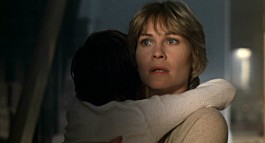 In any case, the 1982 version’s audio compared favorably with the Dolby Digital EX 5.1 soundtrack found on the 2002 feature. The main differences related to some changes made for the newer cut. As I noted earlier, the 2002 edition altered the line about Michael’s Halloween costume, and due to the removal of the guns, one music cue got changed to accommodate the elimination of one shot. Of course, the scenes new to the 2002 edition differed as well. Otherwise, I thought the two soundtracks sounded virtually identical.
In any case, the 1982 version’s audio compared favorably with the Dolby Digital EX 5.1 soundtrack found on the 2002 feature. The main differences related to some changes made for the newer cut. As I noted earlier, the 2002 edition altered the line about Michael’s Halloween costume, and due to the removal of the guns, one music cue got changed to accommodate the elimination of one shot. Of course, the scenes new to the 2002 edition differed as well. Otherwise, I thought the two soundtracks sounded virtually identical.
Though the 1982 cut restored most of the audio from the original release, it eliminated one old cue. At the 86:25 mark, a gurgling vocal noise made by E.T. didn’t appear. It also failed to show up in the 2002 cut. I have no idea why these soundtracks omitted that cue. No, its absence didn’t negatively affect the movie, but as someone who saw the original version many times, its failure to appear seemed very noticeable.
Also on DVD Two we find *A Look Back, a 37-minute and 40-second documentary about the creation of E.T.. An abbreviation of the 90-minute program found on the 1996 deluxe laserdisc release, “Back” includes a few quick movie clips, but mostly it combines shots from the set with then-contemporary interviews with Steven Spielberg, producer Kathleen Kennedy, production illustrator Ed Verreaux, screenwriter/associate producer Melissa Mathison, actors Henry Thomas, Drew Barrymore, Dee Wallace, Robert MacNaughton, and Peter Coyote, voice designer Ben Burtt, filmmaker George Lucas, visual effects supervisor Dennis Muren, director of photography Allen Daviau, production designer James D. Bissell, space ship designer Ralph McQuarrie, and editor Carol Littleton.
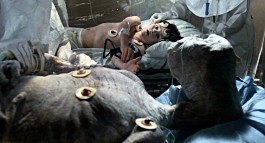 Despite the relative brevity of “A Look Back”, it provides a satisfying view of the production. The show covers many topics, as we hear about the film’s genesis as well as E.T. visual design issues, the development of his voice, some special effects notes, reactions to the finished film and many impressions from the day-to-day production. That latter area offers the program’s best aspects. We get a nice feel for how things went and see lots of great candid images from the set. Overall, those components help make “A Look Back” an entertaining and informative piece.
Despite the relative brevity of “A Look Back”, it provides a satisfying view of the production. The show covers many topics, as we hear about the film’s genesis as well as E.T. visual design issues, the development of his voice, some special effects notes, reactions to the finished film and many impressions from the day-to-day production. That latter area offers the program’s best aspects. We get a nice feel for how things went and see lots of great candid images from the set. Overall, those components help make “A Look Back” an entertaining and informative piece.
So why didn’t Universal include the full documentary? I have no idea. As we’ll see, the package provides new programs on the third disc, but there’s no reason they couldn’t have tossed in the whole 1996 piece. When they halved the Jaws documentary, they did so to make everything fit onto one disc, but that argument doesn’t hold here. While the shortened edition still works, I definitely miss the full cut.
In addition to the film’s original theatrical trailer, disc two houses the sets DVD-ROM materials. In the “Games” area we find a few different pieces. The “E.T. Trivia Game” offers 10 questions of varying difficulty with no reward for successful completion. The “Save E.T. Game” provides a simplistic side-scrolling arcade game. It’s very basic and silly, but it’s actually a little fun, even though it also ends with no prize of any sort. The “Free the Frogs” game is an E.T. version of Pac-Man. It starts easy but gets pretty tricky as it progresses. The production values seem basic, but it’s still moderately enjoyable.
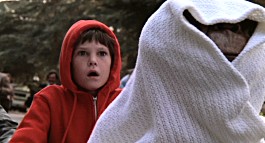 “Dress Up E.T.” lets you do exactly that. You can slide different head, body and feet apparel onto our favorite space monkey and watch the wacky results. Kids may get a kick out of it. “Wallpaper” offers six choices for computer screen visuals, while “Printables” provides six E.T. coloring pages, a cut-out mask, and and an E.T. door hanger.
“Dress Up E.T.” lets you do exactly that. You can slide different head, body and feet apparel onto our favorite space monkey and watch the wacky results. Kids may get a kick out of it. “Wallpaper” offers six choices for computer screen visuals, while “Printables” provides six E.T. coloring pages, a cut-out mask, and and an E.T. door hanger.
In a generally annoying and unpopular move, Universal relegated some extras to their website called “Total Axess”. Right now (late October 2002), this area doesn’t include much. It features two short clips of the 2002 premiere as well as some “exclusive photos”, which offer nothing more than a few promotional shots. Otherwise, “Total Axess” just provides some other promotional material like trailers for different Universal titles and a mix of weblinks. In the pre-release hoopla, I recall hearing that “Total Axess” would feature juicier bits like deleted scenes. Perhaps Universal rethought that, or maybe they’ll appear on some later date, but they ain’t there almost a week after E.T. hit the shelves.
As we move to DVD Three, we find the bulk of the package’s extras. In contrast with the 1996 piece seen on DVD Two, *E.T. the Extra-Terrestrial: The 20th Anniversary Celebration provides a wholly new production. “Celebration” runs 50 minutes and 10 seconds and offers the standard mix of short movie snippets, images from the set, and interviews. The latter come from 2002 and include comments from Spielberg, writer Melissa Mathison, actors Drew Barrymore, Henry Thomas, Dee Wallace, Robert MacNaughton, and Peter Coyote, E.T. creator Carlo Rambaldi, director of photography Allen Daviau, producer Kathleen Kennedy, 2002 edition visual effects supervisor Bill George, 2002 animation supervisor Colin Brady, 2002 animator Shawn Kelly, and 2002 visual effects editor David Tanaka.
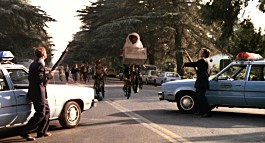 ”Celebration” takes on two separate topics, really. The first 33 minutes or so offer a look at the production of the film and give us more good material from the set as well as additional insight into the flick. We see parts of Henry Thomas’ audition and learn other casting tidbits along with nice information about working with the E.T. puppet. In fact, Barrymore utters one of the best indictments of computer graphics I’ve heard, as she essentially tells us how a CG E.T. would have weakened the film since the kids bonded so strongly with the puppet. “Celebration” doesn’t reiterate too much heard in “A Look Back” and it features some nice material.
”Celebration” takes on two separate topics, really. The first 33 minutes or so offer a look at the production of the film and give us more good material from the set as well as additional insight into the flick. We see parts of Henry Thomas’ audition and learn other casting tidbits along with nice information about working with the E.T. puppet. In fact, Barrymore utters one of the best indictments of computer graphics I’ve heard, as she essentially tells us how a CG E.T. would have weakened the film since the kids bonded so strongly with the puppet. “Celebration” doesn’t reiterate too much heard in “A Look Back” and it features some nice material.
After approximately 33 minutes, the focus shifts to the 2002 special edition. Spielberg tries to explain his rationale for the changes made to the movie. We also learn about the execution of the effects. Given my negative feelings toward the 2002 cut, this area didn’t do much for me, but it helped expand on the alterations.
Another reason to miss the 1996 documentary: “Celebration” hints at segments much better explored in the old program. For example, we see more of Henry Thomas’ audition there, and we get to check out the entire Harrison Ford deleted scene as well as other excised clips. This DVD’s presentation feels like a tease, and the absence of the deleted scenes seems cheesy. One oddity: the two scenes restored to the 2002 cut of E.T. never appeared on the 1996 DVD.
Note that although “Celebration” shows up in the two-DVD edition of E.T., apparently it includes a shortened version. From what I understand, that version only lasts about 24 minutes.
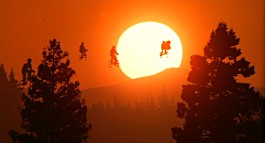 Another feature related to the 2002 reissue, The Reunion provides a 17-minute and 55-second group chat with the flick’s principals. It groups Spielberg, producer Kathleen Kennedy, and actors Henry Thomas, Drew Barrymore, Robert MacNaughton, Drew Wallace, and Peter Coyote. Though it mostly features their comments, it also tosses in some behind the scenes clips and a few movie segments. A fairly fluffy little piece, the shots from the set include the program’s best segments, as they don’t repeat much seen elsewhere. While it’s nice to see the principals reunite, they don’t provide much new information, as we mostly hear facts presented elsewhere. Probably the most compelling bit discusses the scene where the doctors work on E.T. Though nothing special, it merits a look for E.T. fans.
Another feature related to the 2002 reissue, The Reunion provides a 17-minute and 55-second group chat with the flick’s principals. It groups Spielberg, producer Kathleen Kennedy, and actors Henry Thomas, Drew Barrymore, Robert MacNaughton, Drew Wallace, and Peter Coyote. Though it mostly features their comments, it also tosses in some behind the scenes clips and a few movie segments. A fairly fluffy little piece, the shots from the set include the program’s best segments, as they don’t repeat much seen elsewhere. While it’s nice to see the principals reunite, they don’t provide much new information, as we mostly hear facts presented elsewhere. Probably the most compelling bit discusses the scene where the doctors work on E.T. Though nothing special, it merits a look for E.T. fans.
Notably absent from the other supplements, we focus on the film’s composer for The Music of *E.T.: A Discussion with John Williams. In this 10-minute program, we get the usual combination of behind the scenes images and movie clips along with new interviews from Williams and Spielberg. Though fairly rudimentary, Williams offers a decent look at his approach to the film and gives us a reasonable amount of useful information. The highlight comes from an archival clip in which Williams plays the movie’s main theme to Spielberg for the first time.
The 20th Anniversary Premiere runs 17 minutes and 47 seconds and focuses mostly on the live performance of the score during that screening. We hear from composer Williams, 20th anniversary edition editorial assistant Dana Glauberman, music editor Ken Wannberg, Spielberg, Drew Barrymore, Dee Wallace, Kathleen Kennedy, and Henry Thomas. We learn of the challenges presented by the live orchestra premiere and also get to see shots from that production. It’s a decent little piece that nicely illustrates this ambitious undertaking.
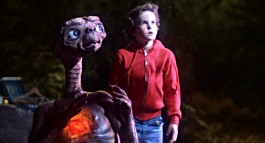 Designs, Photographs and Marketing splits into six smaller areas. E.T. Designs by Production Illustrator Ed Verreaux offers 42 screens of drawings used to influence the creature’s visual look. E.T. Designs by Carol Rambaldi provides 10 screens of similar material, though those take a more technical view toward the work needed to bring the puppet to life.
Designs, Photographs and Marketing splits into six smaller areas. E.T. Designs by Production Illustrator Ed Verreaux offers 42 screens of drawings used to influence the creature’s visual look. E.T. Designs by Carol Rambaldi provides 10 screens of similar material, though those take a more technical view toward the work needed to bring the puppet to life.
In Spaceship Designs by Ralph McQuarrie, we get eight screens of those images, while Designs by Production Illustrator Ed Verreaux tosses in nine screens of more general art such as concept paintings and crew badges. Production Photographs features 139 pictures. Most of these come from the set, but we also see some publicity stills and a few that relate to the special effects. Marketing E.T. includes a mix of 62 publicity stills, ads and merchandise images. All told, these different sections offer a nice little look at the production’s different elements.
In the Theatrical Trailers domain, we get an ad for the 2002 reissue of E.T. as well as a promo for the upcoming DVD release of the Back to the Future trilogy. Cast and Filmmakers includes short biographies for actors Dee Wallace Stone, Peter Coyote, Drew Barrymore, Henry Thomas and Robert MacNaughton as well as director Steven Spielberg, writer Melissa Mathison, and producer Kathleen Kennedy.
More text appears in the Production Notes section. These provide some decent comments about the original production and also toss in some info about the 2002 reissue. Special Announcements features public service promos for the Special Olympics and the Dave Thomas Foundation for Adoption. The former seems interesting since it comes from 1982 and shows E.T. as he encourages a kid to achieve. This area also gives us an ad for the Universal theme parks.
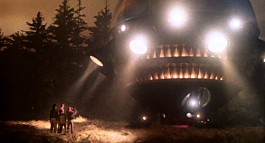 One nice touch: most of the video extras include subtitles. Actually, Universal go farther than most studios in that domain. Not only do we get the standard English text, but we also find Spanish and French translations.
One nice touch: most of the video extras include subtitles. Actually, Universal go farther than most studios in that domain. Not only do we get the standard English text, but we also find Spanish and French translations.
Though that ends the disc-based supplements, the “Ultimate Gift Set” provides some other additions. One offers a compact disc with John Williams’ score, and we also find a senitype; the set describes this as a “limited edition art graphic produced from a single frame of motion picture film and includes one frame of the corresponding film footage.” Neither of those does much for me, but the other physical extra adds a lot to the package. E.T. the Extra-Terrestrial: From Concept to Classic gives us an excellent 192-page hardcover book that covers the scope described in its title. It goes over virtually all aspects of the production via interviews, archival materials and photos, and it also tosses provides the film’s script. The book offers a terrific look at the movie and stands as a must have for E.T. fans.
So does that make the “Ultimate Gift Set” the way to go for E.T. buffs? Maybe not, but every DVD collection should include some version of the flick. Although it doesn’t reside at the top of my list anymore, E.T. remains one of my top ten all-time favorites, and it definitely stands as one of the greatest films ever made. The DVD includes both the original 1982 version as well as the 2002 special edition cut. Both offer very positive picture and sound.
Since I recommend some version of E.T. to everyone, the question becomes which one to get. Frankly, I think the standard two-DVD set makes the most sense for the majority of folks. It provides both versions of the movie and also tosses in many of the bigger package’s extras.
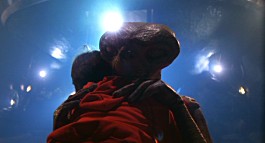 The Ultimate Gift Set retails for more than twice as much as the 2-DVD package, which restricts its appeal to no one other than the biggest E.T. fans. The extra money buys you about 75 minutes of additional video material plus a CD soundtrack and an excellent hardcover book. I don’t care about the CD; movie music does little for me, and I already own the soundtrack that came with the 1996 laserdisc. However, the book provides a fantastic extra, so combined with the additional video pieces, the Ultimate Gift Set merited my attention. If you feel the same interest in these extras, definitely go for this package. Otherwise, you should feel happy with the 2-DVD set, which will cost you substantially less money.
The Ultimate Gift Set retails for more than twice as much as the 2-DVD package, which restricts its appeal to no one other than the biggest E.T. fans. The extra money buys you about 75 minutes of additional video material plus a CD soundtrack and an excellent hardcover book. I don’t care about the CD; movie music does little for me, and I already own the soundtrack that came with the 1996 laserdisc. However, the book provides a fantastic extra, so combined with the additional video pieces, the Ultimate Gift Set merited my attention. If you feel the same interest in these extras, definitely go for this package. Otherwise, you should feel happy with the 2-DVD set, which will cost you substantially less money.

